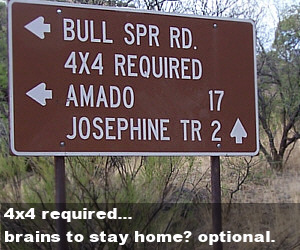A couple of years ago, we had a fabulous adventure in Bisbee, an old copper mining town in the mountains of southeast Arizona. We were tempted to return there, but decided to broaden both our horizons and our listing of southcentral trails, and settled instead on a town called Tubac. We were joined by Florida friend Howard of the south Louisiana "Ham" clan.
As is usual, a comment from a friend led us to this small village some 60 miles south of Tucson and 30 miles north of Nogales. Tubac was purported by said friend to be a charming place, an artistically-inclined village with a historical ambience. I had visions of a colorful, cool, fun and funky town tucked into the craggy foothills of the Santa Rita Mountains. Unfortunately, the only adjective it could muster was 'funky', and not in that 'good funky' sort of way.
 |
| Lots to choose from! |
Tubac sits in the middle of the Sonoran Desert, a wild, rugged landscape filled with many things that can hurt you. Even the pretty flowers come with skin-snagging barbs and often it seemed the entire landscape wanted us dead. That should not be surprising. The name "Tubac" is an English/Hispanic bastardization of a Tohono O'odham tribal word which means, roughly, "rotten." Established in 1795 as a Spanish Presidio, Tubac was on the famed Camino Real, a trail that led from Mexico to the Spanish settlements in California. The rough lifestyle so common in most of the southwest was also present here.
One oft-remembered historical account is of California gambler and highwayman Jack Powers. Despite the literature of the day calling Powers a "gentlemen," Jack was a notorious highway robber and murderer, a bad man who met a violent end. He was murdered just south of Nogales in a fight over a woman, his body unceremoniously thrown into a pen of starving hogs. What little was left of Jack was buried just south of Tubac. It is stories such as these, and plenty of them, that no doubt makes the local Chamber of Commerce cringe.
Lawlessness is still an issue for the area near Tubac, and the southwest as a whole.
The desert trails south of the town skirt the Mexican border, and signs and your imagination provide ample warning of what might happen should you stumble onto a roving band of ill-tempered drug mules.
The U.S. is putting billions into the fight to secure these southwestern borders and evidence of that money is everywhere. Even on the most out-of-the-way and inaccessible trails we saw generally smiling and always diligent U.S. Border Patrol agents, a fact that made Steve, Howard and I very happy.
 |
| What are the chances that a Border Patrol vehicle should drive into our frame just as we snap a joke pic? |
Don't ever depend on having the cavalry ride to your rescue, though. On our first trip to Arizona, Steve asked a border agent whether we should carry a gun on our backcountry excursions. The agent didn't hesitate. "I can never admit that I said this, but I would rather be judged by 12 than carried by six." We got his point.
You will often be lost and find yourself on trails that cannot support human life. Getting Greek food in the middle of southern Arizona is not always a good idea.
If you jam a cactus needle into your shin bone, you will need pliers to get it out. I often thank my lucky stars that Steve is not only a skilled field mechanic, he is a former fire department paramedic, a crucial off-road twofer. But I digress.
 |
| Remember, in Arizona chickens ride for free! |
Many beautiful miles can be logged on dirt and gravel ranch roads, and on a series of what the state calls "Primitive Roads" that criss-cross the region. But most of the true trails in the area seem to attract far more four-wheelers than motorcycles and can be poorly marked. Maps that show unfettered access to open trails are often out of date, leading riders into fences that have apparently been constructed by ranchers laying claim to public land. Another consideration is that Arizona is a 'free range' state so ranchers need only build fences if they desire. Stock can otherwise wander when and where it would like.
There were three particularly enjoyable sets of trails within easy ride of Tubac. Almost due west is the small town of Arivaca. To get there on pavement involves hanging a left on Arivaca Road off Interstate 19 at the Cow Palace, a place you will wish to return for their delicious breakfast skillet concoctions again and again.
Arivaca Road is roughly 20 miles of beautiful. The lightly-traveled road twists, turns and meanders in and out of washes, ravines and hills. To the north are the Cerro Colorado mountains, to the south, the Tumacacori range. Just before you leave Arivaca is a road called "Ruby," who may or may not have taken her love to town.
Ruby Road runs through miles of US Forest Service land with offshoot trails that lead you past played-out mines, to the Mexican border, and to dead ends in obscure places. Less obscure but still lightly traveled is Forest Road 61, a trail along the border that connects Nogales to Bisbee. This stretch of trail runs the gamut from grassland to scrub, from forest to mountain, from easy to uh-oh. Until you reach the last ten miles of the trail near the Coronado National Forest last-nasty-bathroom stop, you will believe that you are the only living souls in the world.
This area is so remote that even the airline contrails don't hang around for long. Understand, however, that you will at some point see a Border Patrol agent, who are all unfailingly courteous in giving motorcycles the right-of-way.
If single-track trail is more your style, bust it up to the Empire Ranch just north of the wine country of Sonoita. Empire Ranch sits in the middle of a 42,000-acre tract of land managed by the US Bureau of Land Management. Originally a working cattle ranch, the facility once encompassed over one MILLION acres, but much of the remaining acreage is open to motorcyclists. Considering that the federal government is not especially friendly to off-roading, this property could become off-limits at any time, so ride it while you can. The trails that travel the expanse of the ranch are well-maintained and not at all technical, which means a lot of easy, non-life-threatening fun. Had our tummies not been urging us on, we would have spent far more time at historic Empire Ranch.
 |
| As seen on a trailriding website. Foreshadowing? |
Not long after, I got a call that Howard's rear tire had flatted, so I returned with the Ford rescue Raptor.
 |
| Howard wears a sad face while contemplating another tire purchase. |
Perhaps this should have been taken as a sign, particularly as it had happened at a point in the trail where several burned-out cars had been left abandoned, but it was not.
Disappointed that they had been bested by the trail, Steve and Howard tried it again a few days later and had to administer even more field triage. A particurlarly entertaining spill ground a hole in the clutch cover of Howard's KTM 530. Luckily, a field fix allowed the adventurers to continue. Bull Springs Road was not a happy place for Howard. Though Steve made it out intact, it is not a place he particularly wishes to return.
None of the trails were forgiving to equipment or bodies, inattention or lack of skill. A hard impact with the ground punched a hole the valve cover in my R1200GS, creating an oil leak.Miles from civilization on inaccessible single track trail would have been a very bad place to be broken down. Luckily, field tools and an epoxy stick patched us up enough to allow us to travel to find more oil.
Another encounter with a wet cattle guard sent me and my GX450 careening into a cactus thicket, also with painful results. Off-roading, like flying, is terribly unforgiving of carelessness, incapacity or neglect. Body armor protected all of us to a large extent, and the cylinders and boxes on my 1200 GS likely prevented a leg injury in my hard tumble. All told, I would prefer repairing scuffed paint than growing more skin or being out of action while waiting for bones to knit.
All in all, though, the trip was another fabulous adventure filled with fun, interesting people, good food, beautiful sights, new experiences and great stories. Our bikes give us the opportunity to do many things and go many places that most people will never be able to experience. Truly, who could ask for more?
Additional Observations:
- Yes, you can hurt yourself off-roading in Arizona, so do not go alone. Also make sure that you have first-aid for both yourself and your bike. An epoxy stick saved us twice. Next time we will also carry a quart of oil.
- Never assume that there will be water, gas or a bathroom where you think they should be. Plan ahead.
- Information on maps regarding trails may or may not be correct. Be prepared to backtrack.
- There are many, many absolutely gorgeous paved roads in southern Arizona if off-roading does not appeal. However, you will be missing out on some true and exquisite beauty if you avoid all unimproved roads.
- There is a nice BMW dealership in Tucson that will repair your bike while asking you, "You took it WHERE?"
- Beware brakes and wet cattle guards. Those two things hate each other.
Two more Interesting Things That Don't Really Go Anywhere Else
During our time in Tubac, the desert was alive with locusts, thousands of them walking across roads and trails. We never figured out exactly what was happening with them but were heartened that no one used the word 'Biblical" in any conversation.
Kitt Peak Observatory is on the Tohono O'odham Reservation about 40 miles west of Tucson and offers nightly observing programs. GO! It will be the best $48 you have ever spent. There are very few places open to the public at which you can reach up and touch Andromeda. Be one who does!
 |
| Andromeda as seen at Kitt Peak. Go on, touch it! |

























No comments:
Post a Comment